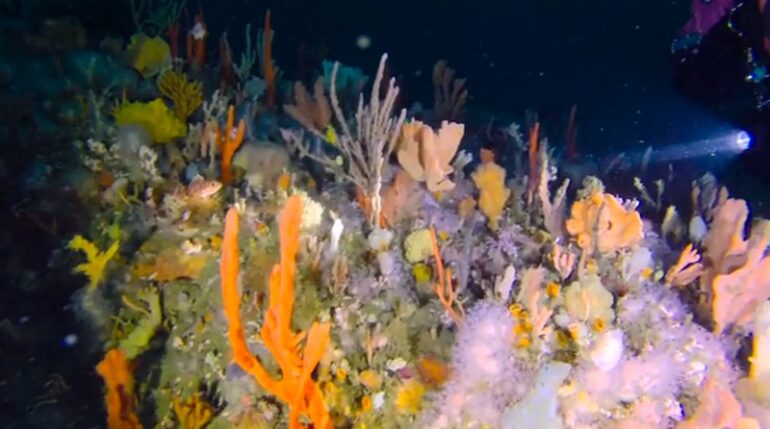Scuba divers off the East Coast of Tasmania have given us the first close-up look at the marine life on deep reefs in the Freycinet Commonwealth Marine Reserve. Their footage shows an explosion of colourful sponges, gorgonian fans and other corals, clouds of butterfly perch, and large, tree-forming black corals that may be new to science.
Researchers with the National Environmental Science Programme (NESP) Marine Biodiversity Hub mapped the 200-metre-long reef using multibeam sonar, and conducted surveys using an autonomous underwater vehicle in 2011. But it wasn’t until this past week when technical scuba divers ventured to the bottom between 60 to 80 metres (200 to 260 ft).

The complex reef system is located on a deep underwater seamount that sticks up into a high current area which brings a non-stop supply of nutrients. Project leader Neville Barrett from IMAS said, these nutrients “support an oasis of life that looks highly valuable in terms of biodiversity and conservation.”
The area is known to local fishers as Joe’s Reef but its exact location had remained a mystery to scientists and managers. Fishermen occasionally visit the area during good weather, but the overall nature of the habitat and the reef fish and invertebrate it supports has been a mystery.

To learn more about the reef the researchers suggested experienced ‘technical’ divers, Tasmanian Scuba Diving Club members James Parkinson and Andreas Klocker, might like to explore it.
“We used the maps to plan the dive and spent about 25 minutes exploring a vertical wall on the north-western edge of the reef, to a depth of 68 meters.” “It’s the best, most exciting ocean diving experience we’ve ever had by a long way,” Andreas Klocker said.

This is the first time that divers have seen tree-forming black corals in the coastal shelf waters. This discovery is a first for James and Andreas and is an exciting new find for science.
“We now know the reef is the jewel in the crown of Freycinet CMR as far as unique features go and we’re keen to explore it further, said Neville. “It’s really exciting to find these amazing reef communities in areas that most people don’t even realise are marine protected areas.” [Marine Biodiversity Hub]



